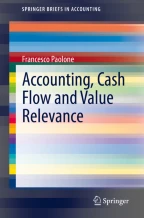The Historical Background of Cash Flow Statement: First Evidences and Contributions

In the past, the Cash Flow Statement has always been an accompanying document to the traditional financial statements, acting as a stand-alone document with the aim of highlighting the level of liquidity and solvency, which is of particular importance for those outsiders who have provided capital.
This is a preview of subscription content, log in via an institution to check access.
Access this chapter
Subscribe and save
Springer+ Basic
€32.70 /Month
- Get 10 units per month
- Download Article/Chapter or eBook
- 1 Unit = 1 Article or 1 Chapter
- Cancel anytime
Buy Now
Price includes VAT (France)
eBook EUR 53.49 Price includes VAT (France)
Softcover Book EUR 68.56 Price includes VAT (France)
Tax calculation will be finalised at checkout
Purchases are for personal use only
References
- Anton HR (1962) Accounting for the flow of funds. Houghton Mifflin, Boston Google Scholar
- Bliss JH (1923) Financial and operating ratios in management. Ronald Press, New York Google Scholar
- Cole WM (1908) Accounts, their construction and interpretation, for businessmen and students of affairs. Houghton Mifflin, Boston Google Scholar
- Collins GW (1946) Analysis of working capital. Account Rev 21(4):430–441 Google Scholar
- Dickerson WE, Jones JW (1931) Some observations on the statement of application of funds. Account Rev:277–281 Google Scholar
- Esquerre PJ (1914) The applied theory of accounts. Ronald Press, New York Google Scholar
- Esquerre PJ (1925) Resources and their application. J Account 39:424 Google Scholar
- Finney HA (1923) The statement of application of funds. J Account:49–62 Google Scholar
- Gilman S (1925) Analysing financial statements. Ronald Press, New York Google Scholar
- Greene TL (1897) Corporate finance. G. P. Putnam’s Sons, New York Google Scholar
- Gregory HE (1928) Accounting reports in business management: use of financial and operating statements, together with a system of standards and performance records in maintaining efficient management and control. Ronald Press, New York Google Scholar
- Gustafson GA (1963) Working paper for preparation of cash-flow statement. Account Rev 38(1):160 Google Scholar
- Guthmann HG (1950) The movement of debt to institutions and its implications for the interest rate. J Financ 5(1):70–87 ArticleGoogle Scholar
- Gynther MM (1968) Future growth aspects of the cash flow computation. Account Rev 43(4):706–718 Google Scholar
- Hatfield HR (1927) Accounting. Appleton and Co., Texas Google Scholar
- Horngren CT (1956) The funds statement and its use by analyst. J Account 101:55–59 Google Scholar
- Jaediche RK, Sprouse RT (1965) Accounting flow: income, funds and cash. Prentice Hall, Englewood Cliffs Google Scholar
- Kafer K, Zimmerman VK (1967) Notes on the evolution of sources and applications of funds. Int J Account 2(2):89–121 Google Scholar
- Kempner JJ (1956) The statement of application of funds in modern corporate accounting practice. The Ohio State University, Columbus, OH Google Scholar
- Kester RB (1933) Advanced accounting, 3rd edn. Ronald Press, New York Google Scholar
- Kohler EL, Morrison PL (1931) Principles of accounting. McGraw-Hill Book, New York Google Scholar
- Mechelli A (2008) Il rendiconto finanziario consolidato. Profili teorici e comportamenti aziendali. Cedam, Padova Google Scholar
- Moonitz M (1943) Inventories and the statement of funds. Account Rev 18(3):262–266 Google Scholar
- Paton WA (1922) Accounting theory. Ronald Press, New York Google Scholar
- Paton WA (1941) Advances accounting. Macmillan, New York Google Scholar
- Paton WA, Stevenson RA (1922) Principles of accounting. Macmillan, New York Google Scholar
- Potito L (1980) Il Rendiconto Finanziario nelle imprese. Giannini Editore, Napoli Google Scholar
- Roberts A.C.-Gabhart D.R.L. Statement of funds: a glimpse of the future? J Account, 1972 133, 54 Google Scholar
- Rosen LS, DeCoster DT (1969) “Funds” statements: a historical perspective. Account Rev 44(1):124–136 Google Scholar
- Scovill HT (1944) Application of funds made practical. Account Rev 19(1):20–31 Google Scholar
- Sellie CN (1943) Fund statement terminology. Account Rev XVIII:160 Google Scholar
- Steyn BW, Hamman WD (2003) Revamping the cash flow statement. Account Res 11:181–198 Google Scholar
- Stolowy H, Walser-Prochazka S (1992) The American influence in accounting: myth or reality? The statement of cash flows example. Int J Account 27(3):185–221 Google Scholar
- Trout K, Tanner M, Nicholas L (1993) On track with direct cash flow. Manag Account 75(1):23–28 Google Scholar
- Wallace RSO, Choudhury SIM, Pendlebury M (1997) Cash flow statements: an international comparison of regulatory positions. Int J Account 32(1):1 ArticleGoogle Scholar
- Wallace RSO, Choudhury SIM, Adhikari A (1999) The comprehensiveness of cash flow reporting in the United Kingdom: some characteristics and firm-specific determinants. Int J Account 34(3):311 ArticleGoogle Scholar
Author information
Authors and Affiliations
- Mercatorum University, LUISS University, Rome, Italy Francesco Paolone
- Francesco Paolone
You can also search for this author in PubMed Google Scholar
Rights and permissions
Copyright information
© 2020 The Author(s), under exclusive license to Springer Nature Switzerland AG
About this chapter
Cite this chapter
Paolone, F. (2020). The Historical Background of Cash Flow Statement: First Evidences and Contributions. In: Accounting, Cash Flow and Value Relevance. SpringerBriefs in Accounting. Springer, Cham. https://doi.org/10.1007/978-3-030-50688-9_3
Download citation
- DOI : https://doi.org/10.1007/978-3-030-50688-9_3
- Published : 30 July 2020
- Publisher Name : Springer, Cham
- Print ISBN : 978-3-030-50687-2
- Online ISBN : 978-3-030-50688-9
- eBook Packages : Business and ManagementBusiness and Management (R0)
Share this chapter
Anyone you share the following link with will be able to read this content:
Get shareable link
Sorry, a shareable link is not currently available for this article.
Copy to clipboard
Provided by the Springer Nature SharedIt content-sharing initiative

